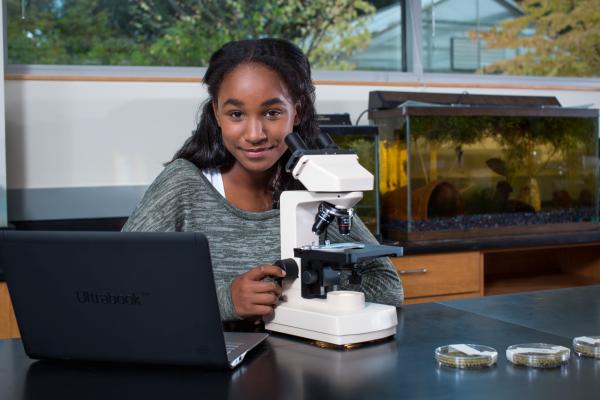In the growing movement to improve STEM (Science, Technology, Engineering, and Mathematics) awareness in young people, increase STEM educational opportunities for underrepresented and minority students, and empower youth to be prepared for the jobs of tomorrow, Computer Science, Engineering, and IT (Information Technology) are some of the hottest topics of interest.
As many know, Intel is a multinational corporation and one of the largest makers of semiconductor chips. Intel invented the x86 series of microprocessors (the microprocessors found in most PCs). The Intel Foundation is a philanthropic organization within Intel that focuses on STEM education and grants around $40 million each year to increase opportunities for underrepresented minorities, girls and women, while also empowering communities and providing support in the wake of global disasters.
In just the past decade, Intel and the Intel Foundation have invested over $1 billion. Intel employees have volunteered almost 4 million hours to improving education in over 70 countries worldwide. Here are some standout STEM programs that have been provided through Intel and the Intel Foundation:
In 2000 Intel began sponsoring the Computer Clubhouse Network, a program in the Boston Museum of Science with support from the MIT Media Lab. This is a community-based after school program that gives resources to underserved young people to develop skills and build confidence in using technology. With over 100 clubhouses in 20 countries, the network has touched the lives of over 25,000 young people.
As engineering can be an academically demanding major for college students, STAY WITH IT is an online community of more than 30,000 to encourage first and second-year engineering students to stay with it and graduate.
The Intel International Science and Engineering Fair Educator Academy brings together educators to collaborate on new methods to engage young people with STEM. In 2012 Lehman College was awarded a planning grant to help establish a culture of science engagement in the Bronx through the Bronx Sci Fest, a high school science fair program.
In the Intel Science Talent Search (America’s oldest pre-college science competition) high school seniors are judged on research projects, along with their leadership skills, giving the top-prize winner a chance to win $100,000. Around 1,700 young STEM leaders representing 400 science fairs from around the country compete for a total of more than $5 million in awards at the Intel International Science & Engineering Fair.
The Fair Play: Design & Discovery initiative, started in 2001(with funding assistance from the US Department of Education) has partnered with the Girl Scouts to engage girls and young women with engineering through participating in the design process. The Intel Design and Discover Summer Program is a curriculum that was implemented in 2004. This curriculum gives underserved inner city youth from Phoenix the opportunity to engage with hands-on engineering and design activities, to increase their problem-solving capabilities and knowledge of STEM in general.
What is unique about Design & Discovery is that it gets kids to think about how engineering and science can positively affect communities and touch the lives of the people they care about. The curriculum also stresses the importance of creativity in the engineering design process, bringing home the newer notion of “STEAM,” with the “A” standing for “Art.”
The Intel Teach Program is a global teacher professional development initiative. Intel Teach has helped more than 10 million teachers worldwide develop the technical skills and resources to prepare them for education in the 21st century.
The Harlem Times recently spoke with Wendy Hawkins, Executive Director of the Intel Foundation. Here are some highlights from the interview:
HT: Tell us about the Computer Clubhouse Network.
Hawkins: “Those clubhouse have aimed at inner city youth, many of whom were disaffected from formal education, and have offered them opportunities to become connected through technology and STEM…and in many ways to reconnect to the world of education through that.”
HT: What about Intel’s work with Lehman College?
Hawkins: “Lehman College and Intel have been partnering to get those kids (inner city) into the science competitions, so that they can to can have the opportunity not just to learn science from text books and that kind of rote memorization…but kind of get your hands dirty and be a real scientist…the opportunity to think open-endedly about answering real questions.”
HT: What is the importance of diversity for IT?
Hawkins: “When you look at a company like Intel…we want our products to touch the lives of every person around the world, when you think of that level of diversity, we can’t hope for guys all sitting in labs who all look alike…to be able to design things for all different colors, men and women, all different flavors around the world, how could they possibly design products that will meet those needs? We need people of all those different colors and all those different flavors in those labs designing those products, imagining what people will need, knowing what it feels like to be those people.”
“We see that in our design labs, when we have diversity—how much more energy there is, how different the ideas are, and how it works. We’re very committed to building that kind of diversity. It’s a great concern to us that there isn’t that kind of diversity coming up through engineering schools, so we’re working very hard to build that diversity in K-12 schools and at the university level, and in maintaining and building it in our own hiring processes, and sustaining it at Intel.”
HT: What’s the importance of teaching young people the power of STEM to change lives?
Hawkins: “It’s really critical for young people who are being drawn into science and engineering that they be able to see that the work that they’re doing will affect the lives of people around them, people that they know…They’re going to make lives better, they’re not just going to solve math problems.”

